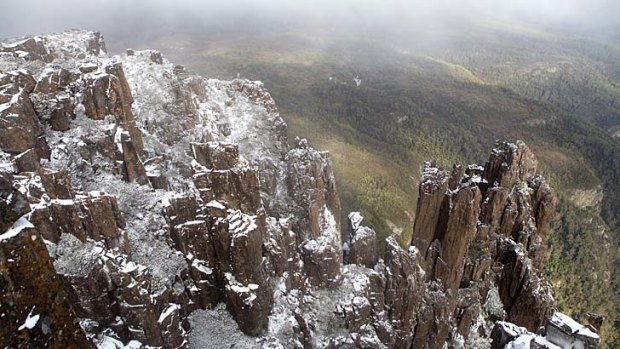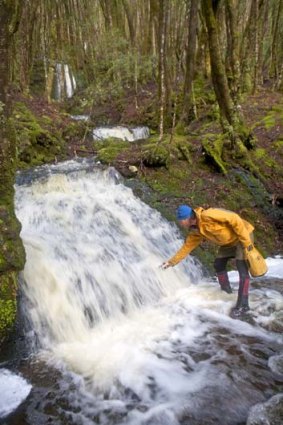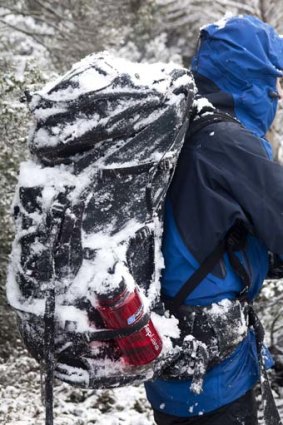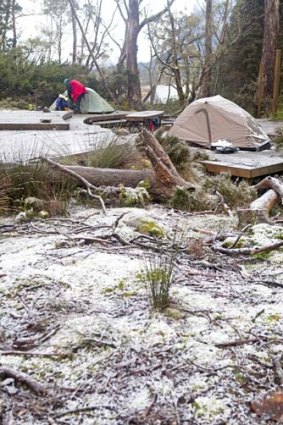
Chilled ... the view from Mount Oakleigh.Credit: Andrew Bain
Andrew Bain walks in splendid frosted landscapes on Tasmania's Overland Track.
There are winter days in Tasmania when the cold, clear air can be like a magnifying glass. Stand on a mountain top in Cradle Mountain-Lake St Clair National Park, without the haze of summer, and some days you can see almost half the length of the state. Today is not one of those days.
It's the middle of winter, almost to the hour, and heavy rain is falling on the peaks around Cradle Mountain. The world has been reduced to mist. If I squeeze my fingers together, waterfalls pour from the tips of my gloves.

The rainforest near Ferguson Falls.Credit: Andrew Bain
I'm here to walk the Overland Track, at a time of year when Australia's most famous walking trail is likely to be all but deserted. My backpack bulges with warm clothing and I'm carrying a pair of snowshoes in hope of dumps of snow. Right now, with so much water rushing down the track, it might have been a more reasonable ambition to raft it.
On the first morning, as I descend from Crater Peak to the Cradle Plateau, I can sense Cradle Mountain ahead, but cannot see it for cloud. I'm fighting rain, hail and wind as I walk, but it's not all a battle. There are delights here - it's just that they're smaller and nearer than the mountains.
For brief moments, the air smells of lemon-scented boronia and the track is like a journey through a Tasmanian field guide. There are pandani that resemble Dr Seuss characters and cushion grass shaped like brain corals. Underfoot are the fallen leaves of Tasmania's fagus, the country's only native winter deciduous tree, looking like spilt potato chips.

A snow-kissed walker.Credit: Andrew Bain
My destination tonight is Waterfall Valley Hut. I'm expecting it to be empty but when I open the door, eight faces look up from their books. It's an indication of the growing popularity of winter walking on the Overland Track, including the launch this winter of guided trips by Tasmanian Expeditions.
Unlike the summer season, which runs from October to May, winter walks require no bookings and incur no fees, but there are more compelling reasons to come in the cold months.
In summer, up to 60 walkers begin the Overland Track every day, but in winter it can feel as though you have Australia's busiest long-distance trail to yourself. Though I share the warmth of the huts with up to 14 other people at night, I see only two other walkers while on the trail.

Camping at New Pelion.Credit: Andrew Bain
Winter conditions also bring vitality to the land, greening the rainforest, yellowing the buttongrass and often blue-ing the sky. The colourful trunks of the cider gums and snow gums gleam like stained glass, and streams that might only be trickles in summer now surge from the mountains.
In the morning I head out from Waterfall Valley on icy paths, virtually skating south as the track skirts the eponymous waterfalls and climbs back into mist. After an hour, my guide, Ben, points into the cloudy distance. "Usually from here you can see all the mountains we'll pass: Pelion East, Ossa, Oakleigh," he says. A few minutes later, he calls again from behind me: "Look, Cradle Mountain." But by the time I turn around, it's gone again. I'm not sure I even believe in Cradle Mountain any more.
It's on the fourth morning, at New Pelion Hut, that the mountains begin to make more than cameo appearances, and the clouds finally bring gifts instead of rain.
When I wake that morning, the sound on my tent is the whisper of snow. It's the most welcome moment of the week - it's not enough to justify the snowshoes, but enough to tempt us to stay a day to climb Mount Oakleigh.
Across the Pelion Plain, this most distinctive of mountains has emerged from cloud, its dolerite spires skewering the sky and its slopes fading to white beneath snow. It'd be a Christmas card scene, were it not for the snow-covered wallabies bouncing across the plain.
To reach Mount Oakleigh we must all but wade across a buttongrass plain - at one point I'm up to my ribs in mud. Past the plain, the trail ascends through rainforest and into a grove of the tallest pandani I've ever seen - some perhaps as high as 10 metres.
Snow continues to fall as we climb, coating our backpacks and jackets until we resemble walking snowmen. Pushing through scrub, we crest the ridge just as the clouds part, unwrapping one of the most impressive mountain skylines in the country.
From the summit edge, the view gets even more dramatic, looking down onto Mount Oakleigh's dolerite spires, each one tipped with snow. A rainbow frames the distant Pelion Plain, which is speckled with lakes. With a snowstorm marching in, it's a brief view and again I'm effectively standing on a rock inside a cloud. But I've seen my white winter.
By the next morning it's raining again. We've completed more than half the Overland Track, but some of its finest scenes are still ahead. And if the track comes into its own anywhere in winter, it's inside the rainforest beyond Pelion Gap and Du Cane Hut.
Pinched between Castle and Cathedral (Castle Crag and Cathedral Mountain), the upper Mersey Valley is characterised more by waterfalls than dolerite-ribbed mountains. The sound of rushing water is constant and the myrtle-beech rainforest is so smothered in moss it's like looking at trees wearing down jackets.
The track's most beautiful section of rainforest also leads to its most impressive waterfalls, with side trails branching away to the Mersey River as it plunges out of the mountains.
In summer these waterfalls are pretty ponytails of water, but in winter they are forces of nature, tumbling like avalanches. At Fergusson Falls even the sun is eclipsed by spray, while at Hartnett Falls, the highest of the waterfalls, there are popular summer lunch spots now submerged by the river. Summer walkers can usually wander beside the river to reach the base of Hartnett Falls, but today I get within 50 metres and I'm thigh-deep in water and awash in spray.
I've now had wet feet for almost a week. I've been a grazing ground for leeches and I've carried snowshoes only as ballast but, for this winter view of these powerful waterfalls and that one perfect snowy day on Mount Oakleigh, it has been worth it.
Andrew Bain travelled courtesy of Tasmanian Expeditions.
FAST FACTS
Getting there
Cradle Mountain, at the start of the Overland Track, is a 2½-hour drive from Launceston. The finish at Lake St Clair is 2½ hours from Launceston and Hobart. Tassielink buses service both ends of the track; see www.tassielink.com.au.
Walking there
Tasmanian Expeditions runs seven-day winter guided trips, with snowshoes, for $2195. This includes guides, all meals and transfers to and from the track. The remaining trips this winter depart on August 26 and September 16 from Launceston. It also runs four-day winter trips to Tasmania's Walls of Jerusalem National Park for $1195. Phone 1300 666 856; see tasmanianexpeditions.com.au.
More information
The Tasmanian Parks & Wildlife Service has details on the Overland Track at parks.tas.gov.au/index.aspx?base=7771.
Sign up for the Traveller Deals newsletter
Get exclusive travel deals delivered straight to your inbox. Sign up now.